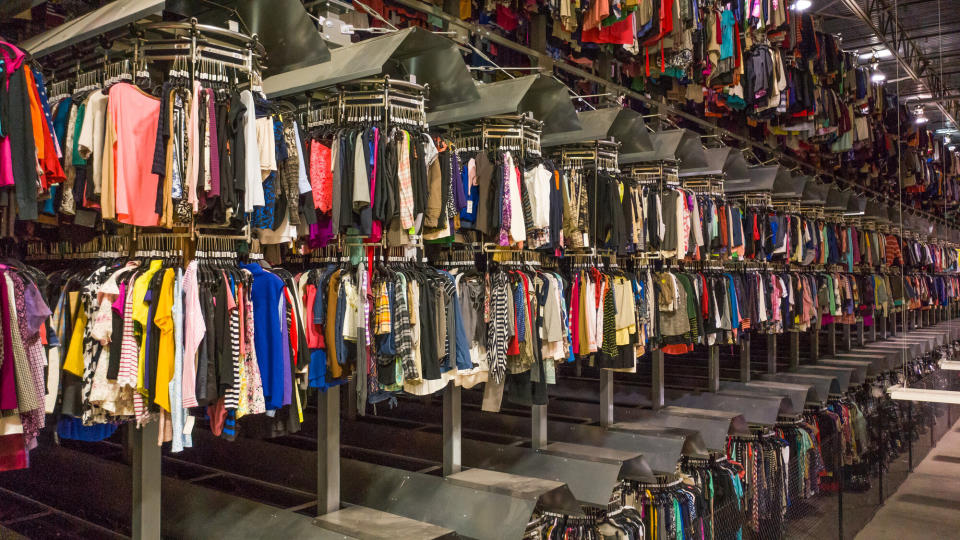The Global Secondhand Market Grew Faster Than Traditional Retail Last Year, According to ThredUp’s Annual Report

ThredUp’s annual resale report is as close to a State of the Union as thrifters are likely to get.
The wide-lens view on the secondhand industry is regularly cited by not just ThredUp but also its competitors, who point to the growth curve it projects as a sign of their own potential.
More from WWD
And the message — again — is that there’s still plenty more potential for resale.
This year’s report, released Wednesday, found the global secondhand apparel market grew by 18 percent last year to $197 billion in gross merchandise value. That is projected to grow three times faster than the overall apparel market and hit $350 billion by 2028. (That is a slight step back, as ThredUp’s report last year said that the industry would log GMV of $351 billion in 2027.)
In the U.S., the secondhand apparel market grew 11 percent, or seven times faster than the broader apparel market, to $43 billion last year, including value of resale sales as well as traditional thrift and donations. That take is expected to rise to $73 billion by 2028.
While the report comes from one of resale’s leading players, the research was conducted by retail analytics firm GlobalData, which relied on its own estimates as well as surveys of 3,654 U.S. consumers and 50 top U.S. fashion retailers and brands.
“The market continues to grow and it’s only growing faster than traditional retail,” said James Reinhart, chief executive officer of ThredUp, in an interview. “A lot of that is driven by consumer preference. Talking about their experience of shopping secondhand, selling secondhand, and really what their expectations are for the future, you just start to see share of closet expand over time.”
Secondhand also offers consumers some respite from the economy.

The report found that 60 percent of consumers see secondhand apparel as giving them “the most bang for their buck,” while 55 percent said they’ll spend more thrifting if the economy doesn’t improve.
“With more than half of all consumers shopping for secondhand apparel last year, it’s evident that resale is now firmly embedded in the fashion landscape,” said Neil Saunders, managing director of GlobalData, in a statement.
“Secondhand buying transcends generations, with the role of resale changing throughout consumers’ lives,” Saunders said. “Younger shoppers turn to secondhand for self-expression and to help create their personal style; parents rely on secondhand to outfit their families in a cost-effective and eco-conscious way, and older generations turn to secondhand to snag affordable, higher-end brands and for the thrill of the hunt.”
Resale’s growth story has been relatively consistent. But the report did single out some other changes in just where people are shopping secondhand.
“You’re starting to see that transition from brick-and-mortar to more online penetration,” Reinhart said. “I think that’s driven by companies like us and others.”
Nearly two-in-three secondhand customers in the U.S. made at least one purchase online last year, an increase of 17 points from 2022, according to the report. Forty-five percent of younger shoppers said they preferred to buy secondhand apparel online. And online resale is expected to more than double to $40 billion in the next five years.
“It’s the first time where you’re seeing preference switch, where you now have a majority who are preferring online versus offline,” Reinhart said. “It used to be that maybe they were an offline thrifter and then they would occasionally buy an item online. And now you’re seeing that they may be maintaining their offline purchases and then incrementally buying even more online. That portends a pretty bright future for the circular economy.”
But that future might need a little extra help.
The report found that 42 percent of consumers say the government should take legislative action to promote sustainable fashion.
“There are two things that government needs to do,” Reinhart said. “One is creating more producer responsibility. Government has shown that if you hold producers of bad things accountable, whether that’s cigarettes or gas emissions, that creates behavior change in an industry. That’s the stick approach.
“And I think the carrot then is government creating incentives and credits for sustainable innovation, fiber-to-fiber recycling plants, investments in circularity, investments in resale and rental and all these things that I think ultimately can help change consumer behavior,” he said.
There has been some movement on the legislative front, especially in France, although activists look for more.
Meanwhile, brands have also gotten behind resale.
The report found that the number of resale shops operated by brands grew by 31 percent last year to 163, with J.Crew, American Eagle and Kate Spade all opening resale sites last year with the help of ThredUp.
Taken together, there’s a lot of alignment around resale, which is actively being embraced by consumers, brands and regulators.
But the resale world is still clearly sorting itself out on the business front with many of the biggest players, including ThredUp and The RealReal Inc. still working their way toward profitability.
It’s been a longer road than many investors hoped for — a fact that has hit shares of ThredUp and The RealReal hard — but Reinhart said resale’s most prominent players are getting there.

“If you look at the trajectory of how our businesses have performed over the last couple of years, I think it’s been an indication of steady progress towards profitability,” Reinhart said. “Our business grew double digits last year and expanded margins on the bottom line. It’s not as though the businesses aren’t growing and driving leverage, I just think there’s a little bit of this narrative of, Why can’t the progress be faster? For us, we’ve expanded in seven of the last eight quarters and the business is significantly bigger than when we went public.
“On the one hand I want to do everything as fast as possible,” he said “On the other hand, I think slow and steady progress where we’re making the right investments over time ultimately is what pays off. We’ve been very clear about being breakeven on a full year basis this year. That’s in our guidance. But I guess RealReal [is] the same way. The markets have punished us for not getting there as fast as they would like, but I think we both showed steady progress. And I feel really good about our positioning in the market.”
Best of WWD

 Yahoo Movies
Yahoo Movies 
